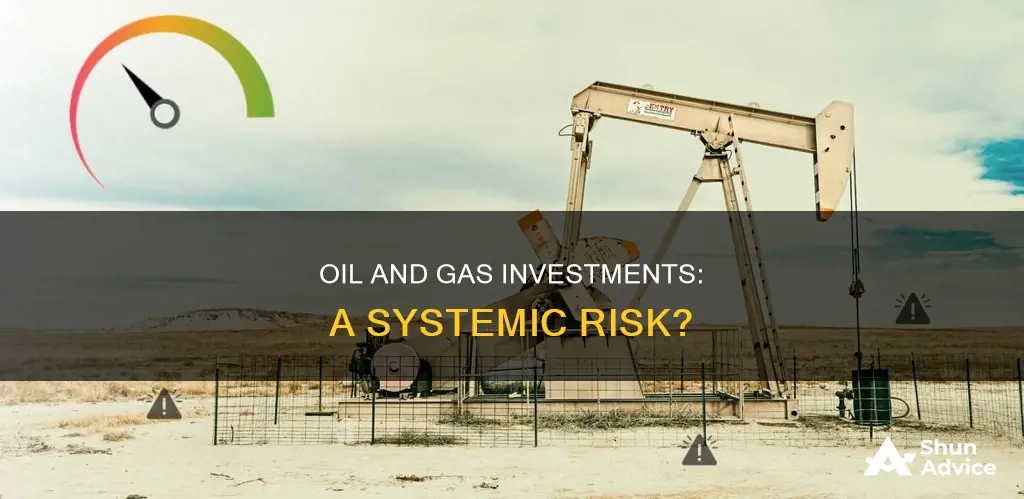
Investments in oil and gas companies are some of the most heavily traded public companies. However, they are not without their risks. The question of whether investments in oil and gas constitute systemic risk has been disputed by a new IHS Energy report, which contradicts concerns by some central banks and regulators that climate change may pose a systemic risk to the financial system. This article will explore the various risks associated with investing in oil and gas, including market volatility, political instability, and project challenges, and analyse their potential impact on the financial system.
| Characteristics | Values |
|---|---|
| Systemic risk | The risk of sharp drops in the valuation of oil, gas and coal companies |
| The risk of overvaluation of oil and gas companies is limited | |
| Oil and gas company valuations are based on reserves that will be produced and monetized over a 10–15-year period | |
| The value of most publicly traded oil and gas companies is based on their proved reserves | |
| Their valuation is based on the present worth of expected cash flow from projects and reserves | |
| Oil and gas companies' reserves are at minimal risk of being stranded | |
| Oil prices are volatile | |
| Oil and gas companies are affected by political instability | |
| Oil and gas companies face geological risks | |
| Oil and gas companies face supply and demand risks | |
| Oil and gas companies face market risks | |
| Oil and gas companies face the risk of investment scams |
What You'll Learn

Oil and gas company valuations
Valuing oil and gas companies requires a unique approach due to the sector's inherent volatility and the significance of reserves and commodity prices. The Net Asset Value (NAV) and Discounted Cash Flow (DCF) methods are widely used in valuing these companies. The NAV approach calculates the present value of a company's reserves, subtracts its liabilities, and adds any additional assets. The DCF method estimates the future cash flows generated by a company's reserves and discounts them to their present value.
Analysts in the oil and gas sector use five common trading multiples to assess company performance: EV/EBITDA, EV/BOE/D, EV/2P, Price/Cash Flow per share, and EV/DACF. These multiples tend to expand in times of low commodity prices and contract in times of high commodity prices.
The history of past transitions suggests that the shift to a lower-carbon economy will be gradual, and the extensive amount of capital invested in the oil and gas industry means that it will continue to play a significant role in the global energy supply for decades to come.
Equities vs Fixed Annuities: Where Should You Invest?
You may want to see also

Climate change and transition risk
Climate change and the transition to renewable energy sources pose significant risks to the oil and gas industry. As the world moves towards the goal of net-zero emissions, the sector faces increasing pressure from policymakers, society, and the market to reduce its substantial contribution to global emissions. Oil and gas companies are expected to rapidly lose market value if they do not make significant changes to their business models.
The risks associated with climate change and the energy transition are twofold: regulatory risk and market risk. Regulatory risk refers to the potential for governments to implement policies that negatively impact the oil and gas industry, such as carbon taxes or emissions regulations. For example, the Paris Agreement has been a watershed moment for the industry, with capital expenditures by firms in the upstream oil and gas sector decreasing significantly compared to other sectors. Additionally, stringent environmental policies can lead to increased costs for high-emitting companies in loan markets, corporate bonds, and higher interest rates from banks.
Market risk, on the other hand, relates to the potential loss of market share and revenue as consumers and investors increasingly favour renewable energy sources over fossil fuels. This risk is particularly acute for oil and gas companies as they are highly exposed to climate transition policies and changes in climate policies. A smooth transition to renewable energy sources requires a move away from fossil fuels, and companies in this industry may experience a substantial fall in revenues and the value of their assets. This is known as the "divestment effect". However, it's important to note that the impact of climate policies on investment in the initial phase of the energy transition is ambiguous, and some models predict an increase in investment in fossil fuels, known as the "green paradox".
The valuation of oil and gas reserves is a key consideration in understanding the climate risks faced by the industry. Oil and gas company valuations are primarily based on reserves that will be produced and monetized over a 10-15 year period. Governor Mark Carney of the Bank of England has warned that a sharp drop in the valuation of these companies due to stranded reserves could threaten financial stability. However, the history of past transitions suggests that the move to a lower-carbon economy will be gradual, and fossil fuels are expected to remain a significant contributor to the global energy supply for decades to come.
In conclusion, climate change and the transition to renewable energy sources pose significant risks to the oil and gas industry, including regulatory, market, and financial risks. However, the pace of the energy transition and the continued demand for fossil fuels mean that these risks may not constitute abrupt systemic risk to the financial system.
Building a Robust Investment Portfolio at 50
You may want to see also

Market volatility
The demand for oil and gas is growing, particularly in developing sectors with heavy energy use. This demand will drive energy consumption that cannot be met by renewable energy alone. However, oil and gas companies face the challenge of dwindling natural supplies in the long term. The exploration for new sources has led to drilling in less friendly environments, increasing the complexity and cost of extraction.
The price of oil and gas is a critical factor in determining the economic feasibility of a project. When prices dip, companies may not be able to quickly shut down and restart operations. As a result, they must carefully forecast prices over the project's term to make informed decisions about whether to proceed. Once a project is underway, price risk becomes a constant concern.
The uneven nature of oil and gas production contributes to price volatility. It takes significant capital and time to start operations, and it is challenging to scale up or down production in response to changing prices. This inflexibility, coupled with unpredictable prices due to worldwide production beyond any single company's control, creates substantial cost concerns for oil and gas companies.
In addition to price volatility, supply and demand shocks pose a significant risk to the industry. The impact of the 2008 financial crisis and other macroeconomic factors can dry up capital and affect the industry independently of the usual price risks. These external factors add complexity and uncertainty to the market, influencing the investment landscape for oil and gas.
Was ist der Job eines Investment Managers?
You may want to see also

Political instability
Oil-exporting countries that hold a central position in this network are more unstable, and their internal instability can increase international oil prices and endanger oil supplies, causing political instability in oil-importing countries. This dynamic is supported by the resource curse hypothesis, which suggests that a high economic dependency on oil exports can increase the risk of instability in these countries.
Additionally, political stability is associated with the legitimacy of a government to enforce laws and provide basic services. A failure of the state, often characterised by internal conflicts or political rivalries, can lead to political instability.
To navigate political instability, investors may consider drilling inside the USA on private land. Overall, political instability is a significant factor that investors in the oil and gas industry must be vigilant about and prepared for to safeguard their investments.
Investment Surpassing Savings: A Recipe for Economic Growth or Debt?
You may want to see also

Geological risks
The presence and effectiveness of several critical elements determine the success or failure of a well. These elements include the source rock, reservoir rock, seal or cap rock, trap, and migration (hydrocarbon charge). If any one of these elements is missing or fails, the well is considered a dry hole. Assessing the probability of discovery is crucial for prospect evaluation, but it has been observed that geologists often perform risk assessments subjectively, leading to large variations in assessments of the same prospect by different companies.
To address this challenge, a standardised risk assessment procedure that can be consistently applied and is as objective as possible is essential. This procedure should involve evaluating the geological factors critical to discovering recoverable quantities of hydrocarbons in a mapped prospect. The probability of discovery is calculated by multiplying the probabilities of the presence and effectiveness of the reservoir, hydrocarbon charge, and retention of hydrocarbons after accumulation.
In conclusion, geological risks in the oil and gas industry are multifaceted and challenging to mitigate. They encompass the inherent uncertainty of exploration drilling, the complex interplay of geological elements, and the subjective nature of risk assessments. Developing and implementing standardised, objective risk assessment procedures is vital to improving the accuracy of evaluations and helping companies make more informed decisions.
Investment Management Fees: Are They Deductible on Form 1041?
You may want to see also
Frequently asked questions
There are differing opinions on this. Some central banks and regulators believe that climate change may pose a systemic risk to the financial system. However, an IHS Energy report disputes this, stating that the risk of overvaluation of oil and gas companies is limited due to how fossil fuel reserves are valued.
The argument is that climate change, specifically transition risk, could threaten financial stability via a sudden and significant collapse in asset values. This is known as the "carbon bubble" thesis.
The counterargument is that oil and gas company valuations are primarily based on reserves that will be produced and monetized over a 10-15 year period, which is a relatively short time frame in which an energy transition is unlikely to occur. Additionally, the history of past transitions suggests that the move towards a lower-carbon energy economy will be gradual and can be priced in by the market over time.
There are several other risks associated with investing in oil and gas, including market volatility, political instability, project challenges, geological risks, and the possibility of investment scams.
Investors can mitigate risks by conducting thorough due diligence, being aware of potential pitfalls, and developing a well-thought-out strategy. It is also important to understand and prepare for market swings and to have a long-term view of investing in oil and gas wells.







